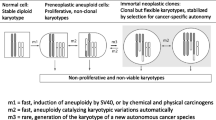Abstract
Retroviral insertional mutagenesis has been proposed as an efficient mechanism to turn on or to increase the expression of oncogenes in several avian or mammal models. Integration site studies of avian leukosis virus, murine leukaemia and murine mammary tumour viruses led to the coleutification of highly conserved genes whose expression is induced or increased during leukaemogenesis, probably through enhancer elements present in the retroviral long terminal repeats1–12. This is reminiscent of the activation of cellular proto-oncogenes or putative oncogenes in numerous human tumours and leukaemias as a result of chromosomal translocations or DNA rearrangements. Here we report the characterization of a new putative oncogene isolated from a murine erythroleukaemia induced by the acute leukaemogenic retrovirus spleen focus forming virus (SFFV). An important and unusual feature of this genomic locus Spi-l (for SFFV proviral integration) is that rearrangements due to SFFV integration were found in 95% of the erythroid tumours studied. A 4.0-kilobase messenger RNA was detected in rearranged tumours. NoSpi-l rearrangement was detected in other virally induced myeloid, lymphoid or erythroid tumours tested.
Similar content being viewed by others
References
Hayward, W. S., Neel, B. G. & Astrin, S. M. Nature 290, 475–480 (1981).
Noori-Daloii, M. R., Swift, R. A., Kung, H., Crittenden, L. B. & Witter, R. L. Nature 294, 574–576 (1981).
Fung, Y. T., Lewis, W. G., Crittenden, L. B. & Kung, H. Cell 33, 357–368 (1983).
Shen-ong, G. L. C., Potter, M., Mushinsky, J. F., Lavu, S. & Reddy, E. P. Science 225, 1077–1080 (1984).
Nusse, R. & Varmus, H. E. Cell 31, 99–109 (1982).
Peters, G., Brookes, S., Smith, R. & Dickson, C. Cell 33, 369–377 (1983).
Cuypers, T. H. et al. Cell 37, 141–150 (1984).
Tsichlis, P.N., Strauss, P. G. & Lohse, M. E. J. Virol. 56, 258–267 (1985).
Lemay, G. & Jolicoeur, P. Proc. natn. Acad. Sci. U.S.A. 81, 38–42 (1984).
Silver, J. & Kozak, C. J. Virol. 57, 526–533 (1986).
Sola, B., Fichelson, S., Bordereaux, D., Tambourin, P. & Gisselbrecht, S. J. Virol. 60, 718–725 (1986).
Villemur, R., Monczak, Y., Rassart, E., Kozak, C. & Jolicoeur, P. Molec. cell. Biol. 7, 512–522 (1987).
Tambourin, P. E., Wendling, F., Jasmin, C. & Smadja-Joffe, F. Leuk. Res. 3, 117–129 (1979).
Wendling, F., Moreau-Gachelin, F. & Tambourin, P. Proc. natn. Acad. Sci. U.S.A. 78, 3614–3618 (1981).
Mager, D., Mak, T. & Bernstein, A. Nature 288, 592–594 (1981).
Wolff, L. & Ruscetti, S. Science 228, 1549–1552 (1985).
Wolff, L., Tambourin, P. & Ruscetti, S. Virology 152, 272–276 (1986).
Linemeyer, D. L., Menke, J. G., Ruscetti, S. K., Evans, L. H. & Scolnick, E. M. J. Virol. 43, 223–233 (1982).
Mowat, M., Cheng, A., Kimura, N., Bernstein, A. & Benchimol, S. Nature 314, 633–636 (1985).
Moreau-Gachelin, F., Robert-Lezenes, J., Mathieu-Mahul, D., Gisselbrecht, S. & Larsen, C. J. Biochimie 65, 259–266 (1983).
Moreau-Gachelin, F. et al. J. Virol. 57, 349–352 (1986).
Moreau-Gachelin, F., Robert-Lezenes, J., Wendling, F., Tavitian, A. & Tambourin, P. J. Virol. 53, 292–295 (1985).
Karn, J., Brenner, S., Barnett, L. & Cesarini, G. Proc. natn. Acad. Sci. U.S.A. 77, 5172–5176 (1980).
Linemeyer, D. L., Ruscetti, S. K., Menke, J. G. & Scolnick, E. M. J. Virol. 35, 710–721 (1980).
Chow, V., Ben-David, Y., Bernstein, A., Benchimol, S. & Mowat, M. J. Virol. 61, 2777–2781 (1987).
Robert-Lezenes, J., Moreau-Gachelin, F., Meneceur, P. & Tambourin P. Leuk, Res. 8, 975–984 (1984).
Author information
Authors and Affiliations
Rights and permissions
About this article
Cite this article
Moreau-Gachelin, F., Tavitian, A. & Tambourin, P. Spi-1 is a putative oncogene in virally induced murine erythroleukaemias. Nature 331, 277–280 (1988). https://doi.org/10.1038/331277a0
Received:
Accepted:
Issue Date:
DOI: https://doi.org/10.1038/331277a0
- Springer Nature Limited
This article is cited by
-
FANCA deficiency promotes leukaemic progression by allowing the emergence of cells carrying oncogenic driver mutations
Oncogene (2023)
-
An oracle predicts regulators of cell identity
Nature (2023)
-
Expression profile of PU.1 in CD4+T cells from patients with systemic lupus erythematosus
Clinical and Experimental Medicine (2021)
-
Bioinformatic identification of candidate biomarkers and related transcription factors in nasopharyngeal carcinoma
World Journal of Surgical Oncology (2019)
-
The ETS family of oncogenic transcription factors in solid tumours
Nature Reviews Cancer (2017)





